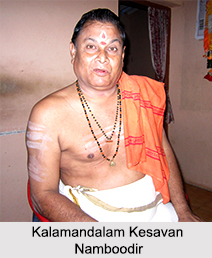 Kalamandalam Kesavan Namboodiri was famous for his more than 40 short plays for kathakali. He learned Kathakali from 1972 to 1983 in Kerala Kalamandalam. He practised Kathakali under many famous teachers namely Kalamandalam Ramankutty Nair, Kalamandalam Padmanabhan Nair, Kalamandalam Gopi, Vazhenkata Vijayan, Kalamandalam Vasu Pisharodi and Kalamandalam M.P.S. Namboodiri.
Kalamandalam Kesavan Namboodiri was famous for his more than 40 short plays for kathakali. He learned Kathakali from 1972 to 1983 in Kerala Kalamandalam. He practised Kathakali under many famous teachers namely Kalamandalam Ramankutty Nair, Kalamandalam Padmanabhan Nair, Kalamandalam Gopi, Vazhenkata Vijayan, Kalamandalam Vasu Pisharodi and Kalamandalam M.P.S. Namboodiri.
Early life of Kalamandalam Kesavan Namboodiri
Kalamandalam Kesavan Namboodiri was first trained by his uncle Neettiyath Govindan Nair who prepared him in percussion. He was later trained in Kathakali "melam" stalwarts like Moothamana Kesavan Namboodiri and Thiruvallwamala Venkinchan Swamy at Poomully Mana in Palakkad district. He was born on May 18, 1936 as the son of Kurukkattumanakkal Vamanan Namboothiri and Neettiyathu Janakiamma, at Peringode, Palakkad.
Career of Kalamandalam Kesavan Namboodiri
He learned Kathakali from 1972 to 1983 in Kerala Kalamandalam. He performed Kathakali under several famous teachers. He had performed Kathakali in numerous stages all around India and in foreign countries. His knowledge is in "Minukku" characters along with “Pacha", "Kathi", "Thadi" characters also. He directed the Kathakali "Sreekrishnaavatharam" which is written by Nalloorpalli Vamanan Namboodiri and presented in a lot of stages. Now he is working on "Kirathasoonucharitham" Kathakali which is written by Kottarathil Sankunni.
He joined the Kerala Kalamandalam in 1954, where he came under the kathakali masters like Kalamandalam Krishnankutty Poduval and Appunni Poduval. After graduating from Kalamandalam, Kesavan worked with Kala Sadanam, Chunangad and RLV Institute, Thripunithura. He had also worked as a teacher at F.A.C.T Kathakali School as chenda master in Aluva for 30 years. At the age of 65, Keshavan debuted in the film Marattam. Since then he acted in a number of films including The Car, Don Bosco, Nadan Pennum Nattupramaniyum, Varavai, Saivar Thirumeni and Oru Katha Pole.
Awards of Kalamandalam Kesavan Namboodiri
He was the recipient of Kerala Kalamandalam Award, Kala Sahithya Academy Award for his Collection of poems Thenthully, Ravunni Menon Memorial Award and N.K. Pisharadi Award.
Personal life and Death of Kalamandalam Kesavan Namboodiri
He was married to Parvathy. They had a daughter and two sons. He died on April 25, 2009 following a heart attack at his house Elamakkara, Kochi. He was 73 years old.



















